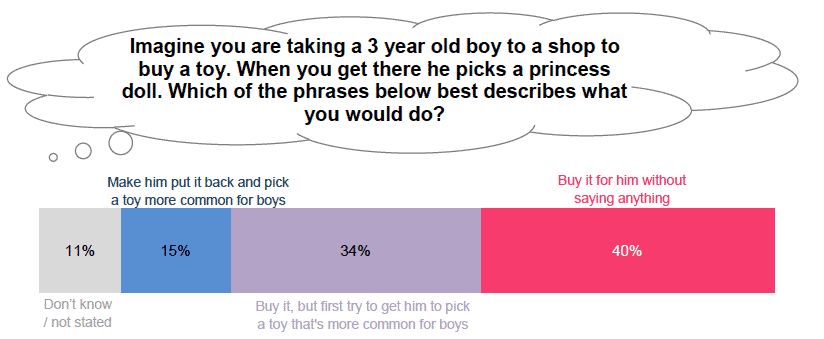Young People's Attitudes To Violence Against Women Report On Findings From The Young People In Scotland Survey 2014
Findings from the 2014 Young People In Scotland survey on the attitudes of young people (aged 11-18) to violence against women.
Influence of gender stereotypes

International research shows that there is a direct relationship between adherence to gender stereotypes and violence against women - people who hold gender-stereotyping attitudes are also more likely to hold attitudes tolerant of violence against women. The 2014 Scottish Social Attitudes Survey found that this is also the case in Scotland for adults. Those who held stereotypical views on gender roles were consistently less likely to view a wide range of abusive behaviours as wrong or harmful.
For the purpose of this analysis:
- • Young people who hold stereotypical views on gender roles are defined as the 15% who would make the boy put the doll back and pick a toy more common for boys
- • Young people who do not hold stereotypical views on gender roles are defined as the 40% who would buy the boy the doll without saying anything.
This is in line with how stereotypical gender views were defined in the Scottish Social Attitudes Survey 2014, and has been chosen here to allow comparisons between the views of young people and adults. Within the Scottish Social Attitudes Survey, the question about buying a princess doll for a boy was chosen as it is the one that appears the more likely to reveal a stereotypical outlook on gender roles, and was therefore used to assess whether there is a relationship between having such an outlook and attitudes towards the various behaviours outlined in the scenarios.
Amongst respondents to the Young People in Scotland survey, holding gender stereotypical views on gender roles was associated with responses to most questions. [3] In general, those who held stereotypical views were significantly less likely to class a range of behaviours as very seriously wrong.
The behaviours that those who held stereotypical views of gender were less likely to class as very seriously wrong included physical violence (a man slapping his wife after finding out she has had an affair), controlling behaviour (a man trying to stop his wife going out with friends) and stalking and harassment (a man putting naked photos of his ex-girlfriend online without telling her, and a woman being wolf-whistled at by a group of strangers).

In addition, those who held stereotypical gender views were also less likely to believe that certain stalking and harassment behaviours would cause a women a great deal of harm (a man posting naked photos of an ex-girlfriend online without telling her, and a woman being wolf-whistled at by a group of strangers).


Those who hold stereotypical views about gender are also less likely to think it should be against the law to put naked photos of an ex-girlfriend on the internet.
For both young people and adults, holding stereotypical views on gender was associated with more permissive attitudes to violence against women (less likely to class a number of behaviours as very seriously wrong, or likely to cause a great deal of harm).
As noted earlier, young people tend to be more permissive about violence against women than adults, yet are equally as likely to buy a small child a toy not typically associated with their gender, thus demonstrating similar levels of non-stereotypical gender views. This would appear to indicate that holding stereotypical gender views is not the key driving factor behind the differences between young people's and adults' attitudes to violence against women.
Contact
There is a problem
Thanks for your feedback